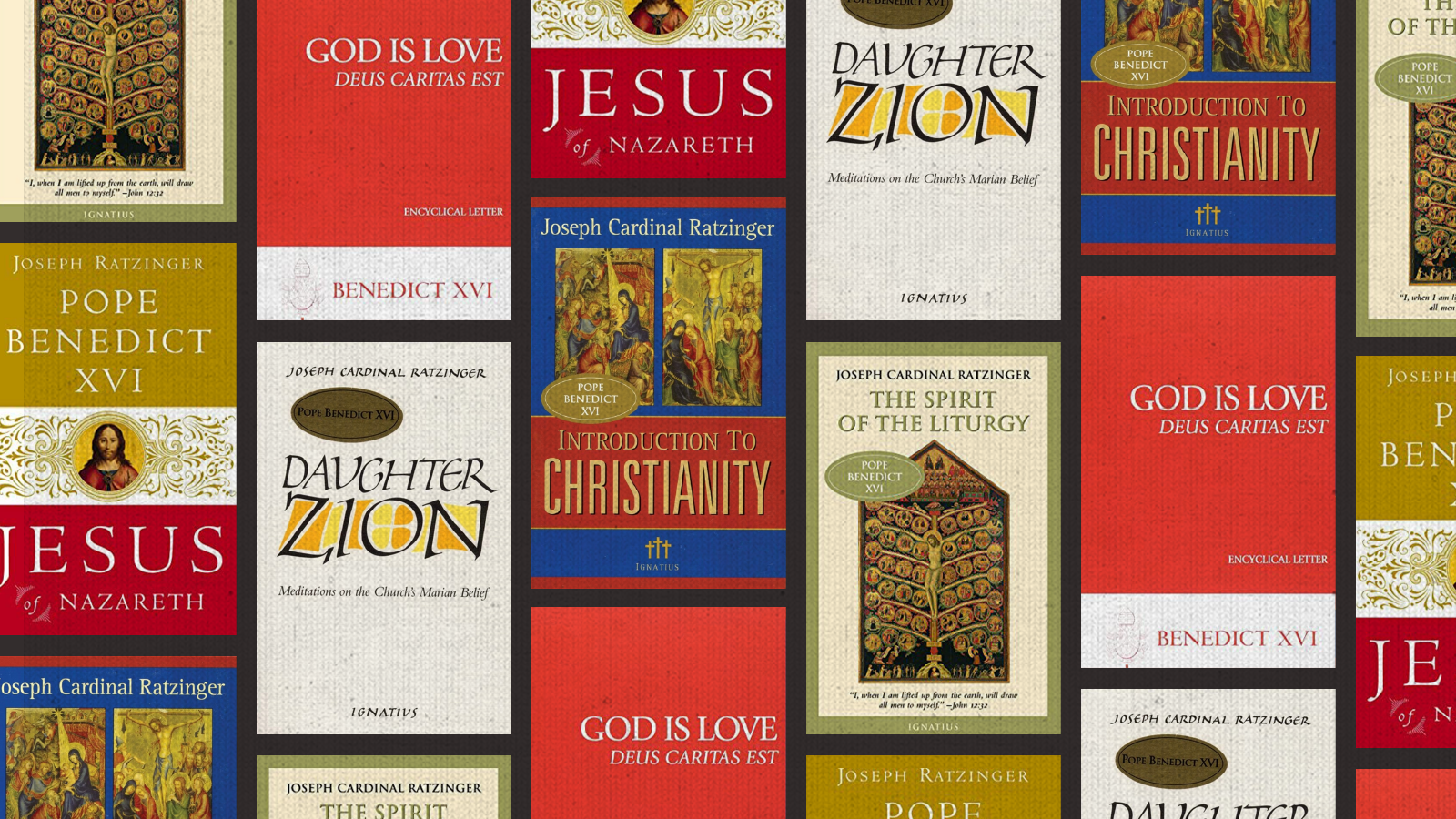In his preface to Teaching and Learning the Love of God, Pope Francis affirms the claim that Benedict XVI will go down in history alongside St. Leo the Great as one of the great popes and doctors of the Church. People often wonder what it was like to witness the pastoral genius of Ambrose or listen to the stirring dissertations of Bernard. In the same manner, future generations will envy our own, wishing they were alive to experience the theological brilliance and spiritual clarity of Joseph Ratzinger.
Personally, I sympathize with Gregory of Nazianzus when eulogizing the life of his friend Basil. For, “I know not what subject I can treat with eloquence, if not this; or what greater favor I can do to myself, to the admirers of virtue, or to eloquence itself than express my admiration for this man” (Oration 43). To me, Benedict XVI was not just a pope but a mentor and guide. Many a night I spent in the seminary library pouring over his books, struck by the lucidity of his rhetoric and the honesty of his thought. Every text so clearly revealed the fundamental logic of reality, one rooted in that single Logos through whom we “live and move and have our being” (Acts 17:28).
Ratzinger taught me how to be a theologian who thinks and prays with the Church, seeing all things in the light of God’s providential love. As a priest, he constantly reminded me of the centrality of the sacred liturgy, and that there is no greater work a pastor provides his flock than the operi Dei of Christ in the sacraments. Most of all, Benedict inspired me to be a vir ecclesiaticus, “a man of the Church,” and a faithful steward of Catholicism.
Benedict’s repertoire is staggering. Few theologians have such an impressive and influential collection of works, not to mention homilies, articles, catecheses, and lectures. As a well-known Ratzinger fan—to put it lightly—I am often asked which books are my favorite as well as where to start if you are a first-time Ratzinger reader. With that in mind, I would like to offer a “Top Five Ratzinger Books list” trusting that one of the best ways I can honor the life of this holy pope is by getting more people to read his writings and be formed by his wisdom.
Jesus of NazareTH
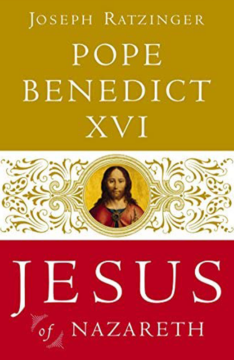
A three-volume work detailing the Incarnation, public ministry, and Paschal Mystery of Christ, Jesus of Nazareth represents the crystallization of Ratzinger’s 60-year theological development. It is his quintessential work and a perfect place to see the pope’s greatest qualities—not only as a theologian but as a pastor of souls. Utilizing his prodigious knowledge of both Sacred Scripture and Patristics, Ratzinger presents a moving reflection on the life of Christ that is scholarly, yet relatable. In his own words, the book represents a “personal search for the face of the Lord,” a fact that shines through on every page.
In my opinion, this series reveals Ratzinger’s heart in a way unlike his other writings. The reader is immediately drawn by the tenderness and sincerity of each chapter. It is often said that one of Ratzinger’s gifts is his ability to say profound things simply. Jesus of Nazareth is a prime example. The volume on Holy Week is particularly beautiful. I read it every year during the season of Lent. Specifically, Ratzinger’s considerations on the Garden of Gethsemane are a perennial point of reflection in my spiritual life. To think the Passion of the Son is not merely a somatic suffering through the tortures of crucifixion but also a metaphysical agony in which the Son drinks the “chalice of wrath” prophesied by Jeremiah (Jer. 25:15-38). Ratzinger writes that there is a special “horror felt by him who is Life itself before the abyss of the full power of destruction, evil and enmity with God . . . that he now takes directly upon himself, or rather, into himself, to the point that he is ‘made to be sin.’”
These kind of theological insights riddle the pages of the Jesus of Nazareth series. It is a must-read for anyone wanting to get acquainted with the late pope’s work.
The Spirit of the Liturgy
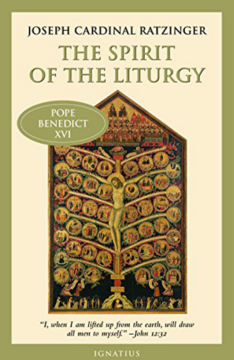
By his own admission, the sacred liturgy was a central reality of Ratzinger’s life both personally and theologically. It was his love for the liturgy that partly led him to study fundamental theology, a field that deals with man’s right response to the revelation of God and thus the liturgy per se (The Collected Works: Theology of the Liturgy). This is evident throughout Ratzinger’s works. No matter the topic, he always returns to the liturgy as the concrete expression of God’s saving work in history. It is in the sacramental life of the Church that we encounter the living God who has “become flesh and dwelt among us” (John 1:14).
Christianity is not a religion of abstraction or ethics; it is a faith that necessitates encounter. For this reason, Christ goes to great lengths to emphasize his ‘bodiliness’ after the Resurrection: “Look at my hands and my feet, that it is I myself. Touch and see, because a ghost does not have flesh and bones as you can see I have”(Luke 24:39; emphasis added). And again, “Put your finger here and look at my hands. Reach out your hand and put it into my side. Stop doubting and believe” (John 20:27). Thus, it is Christ’s being in the flesh that acts as the medium of encounter with divinity. His body is what we must touch to dispel doubt and foster belief.
Jesus is not a phantom or idea; he is a person. What he leaves behind for his Apostles is not just a set of teachings but himself. The way he leaves himself for us is the sacred liturgy. The liturgy is Christ actively being in history. The worshiping act of the Church, therefore, is the locus of communion with God. Ratzinger sought to renew this understanding of the essential role of the liturgy in Christianity. With this in mind, he penned The Spirit of the Liturgy, as a summation of his liturgical thought.
The book is divided into four parts. The first deals with the essence of the liturgy. As always, Ratzinger begins with a foundational question: “What is the liturgy?” This leads to a comprehensive reflection starting with an exegesis on the book of Exodus and the liberation of the Israelites. In my opinion, chapter 1 of The Spirit of the Liturgy remains one of the best theological analyses of Exodus in modern history. In less than ten pages, Ratzinger provides an enlightening thesis on Exodus, not as only as a geo-political or sociological event, but more importantly, a liturgical event in which God consecrates the Hebrews to himself as a worshiping community. What will distinguish the Jews among the other nations is their liturgy. It is for this reason that God gives them the Promised Land—not for the sake of the land itself but as a place preserved for liturgical practice. By itself, the land is dirt. But through the liturgy, it becomes a divine dwelling where the Creator Himself abides. Thus, “the only goal of the Exodus is shown to be worship.”
Outlining The Spirit of the Liturgy in its entirety lies outside the scope of this article, but the above-written commentary provides a general sense of Ratzinger’s liturgical ethos. Suffice it to say, this text is invaluable to anyone hoping to understand the mind and heart of Joseph Ratzinger, not to mention the rich liturgical theology of Catholicism.
God Is Love (Deus Caritas Est)
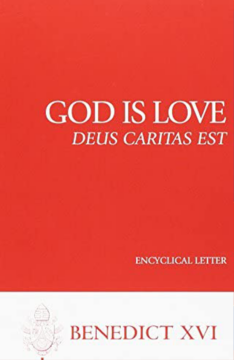
This is the first Ratzinger book I ever read. I was a sophomore in high school at the time. My parents used to take the kids to Barnes & Noble almost every weekend since it was not far from the parish. Naturally, each child had their preference for literature. My sister was the novelist, whereas my brothers were inclined to fantasy, science, and anime. When not minding my younger siblings, I would typically bounce between reading military history with my father and browsing the theology section with my mother. There, I spotted God Is Love.
I read the text in between serving customers at the Publix bakery. I had never seen anything like it. It was there, behind the pastry counter of a supermarket, that Ratzinger’s genius first struck me. What is more, every word he wrote gave voice to my heart, affording me a vocabulary by which to express my own nascent philosophical musings.
When initially elected to the papacy, there was anxiety about the pastoral sensitivity of the infamous “Panzerkardinal.” Having proven himself a stalwart defender of Catholicism while head of the Congregation for the Doctrine of the Faith, some feared Ratzinger would lack the kindness and amicability of the late St. John Paul II. His first encyclical, however, put the world at ease. For this pope would begin his reign not with condemnation but with love.
At the core of Ratzinger’s brilliance is his ability to read the signs of the times and put his finger on the pulse of society. In his first encyclical as pope, he recognized that the world was losing sight of Christianity’s foundational premise—namely, that God is personal and loving. He is not a super-transcendent reality, untouchable and unrelatable. “Being a Christian is not the result of an ethical choice or lofty idea, but the encounter with an event, a person, which gives life a new horizon and a decisive direction.”
Although I recommend Jesus of Nazareth as the most complete introduction to Ratzinger’s thought, I suggest God Is Love as the most approachable. It is a short text, barely a hundred pages. Yet, it lacks nothing of the pontiff’s virtuosity and provides the reader with a good sense of his writing style.
Introduction to Christianity
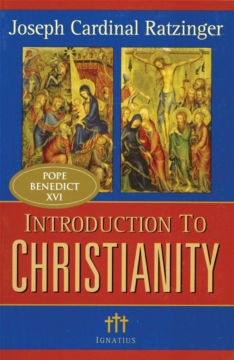
Introduction to Christianity is perhaps the most well-known and widely read of Ratzinger’s works in the English-speaking world. The book certainly highlights his gifts as a fundamental theologian. Beginning with a reflection on the state of belief in the post-modern world, Ratzinger leads the reader through a three-part reflection on the Father, the Son and the Holy Spirit elaborating on the foundational aspects of the Catholic faith. Yet again, this work illustrates Ratzinger’s grasp on the trends in Western civilization. In particular, he calls out the secular inclination to exile religiosity to the realm of subjective belief.
According to Ratzinger, religion is not something purely private nor is it something that is ethereal and removed from our real-life experience. In fact, it is an all-inclusive reality that effects the whole of history: “Christian belief is not merely concerned, as one might first suspect from all the talk of belief or faith, with the eternal which as the ‘entirely Other’ would remain completely outside the human world and time; on the contrary, it is much more concerned with God in history, God as man.”
History is a key theme in all of Ratzinger’s writings but not the stale understanding of history as a list of events and dates. To Ratzinger, and indeed Catholic tradition as a whole, history is not a fact that has passed but an act that is happening. History is a pilgrimage. The universe is going somewhere. In other words, history is not just a collection of random and coincidental events, but rather a story guided by providence in which God himself is an active participant. Christ is the fulfillment and end of history. In him, we see both where we come from and where we are going. He is the Alpha and Omega.
The book is a bit more philosophically and theologically heavy than some of the other works we mentioned so far, but it is a great read that showcases Ratzinger’s intellectual prowess. For those who might be searching for a challenging yet rewarding text, Introduction to Christianity is the book for you.
Daughter Zion
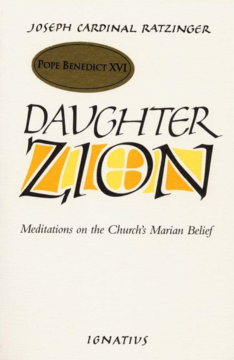
At the turn of the century, a movement known as ressourcement began to spring up among theologians throughout the Church. Thanks to the discovery of ancient patristic and liturgical texts during the eighteenth and nineteenth centuries, Catholic theology experienced a sweeping revitalization, specifically in the fields of ecclesiology and Mariology. Joseph Ratzinger is one of the prime examples of a ressourcement theologian. His writings do not fit neatly into any specific theological school, such as Thomism or Augustinianism. Rather, his thought denotes an expansive and basic quality, as if he taps into the original wellspring of the Christian logos. In that way, many of Ratzinger’s works are reminiscent of patristic texts like the catecheses of Cyril or Maximus’ chapters on theology.
One such example is Ratzinger’s little book on the Blessed Virgin Mary entitled Daughter Zion. It is one of his shortest works, just over eighty pages. In it, he summarizes the Church’s belief regarding Mary and her role in salvation history. Mary is not important only because she is the Mother of God. Our Lady also plays an indispensable part in the very infrastructure of Christianity itself. Without Mary, there is no Church, our religion is sterile; for there is no womb in which it can take root. She is the New Eve to the New Adam. There must be at least one person who assents to the Son without reserve, defilement or duplicity. That is Mary. As Adrienne Von Speyr so beautifully states it, Mary is the Father’s promise to the Son that his work will bear fruit in the hearts of men (Mary in the Redemption, Ignatius Press, pg. 17).
Ratzinger notes how it is impossible to appreciate Mary apart from the typology of the Old Testament. In fact, Mary’s part in salvation constitutes the first prophecy in scripture spoken immediately after the Fall in Genesis 3:15. The rest of Old Testament history will be an attempt to reconcile the failure of Eden and in the background of every event is that mysterious woman whose womb will crush the head of the serpent. Thus, God will allude to Israel, Zion and Jerusalem as his daughter and bride. The love God has for his people is not neutered. It is fertile and seeking communion. It awaits a faithful daughter of Israel who will be fully receptive to its fecundity. That daughter is found in the meadows of Nazareth. It is at that moment that “the figure of the woman, until then seen only typologically in Israel although provisionally personified by the great women of Israel, also emerges with a name: Mary.”
Christ’s Church cannot be understood without from Mary. She is the prism in which the single light of Christ shines casting a spectrum of faith through the hearts of God’s People. If you want a good resource for learning about the role of Mary and her importance in salvation, Daughter Zion is a great place to start.
